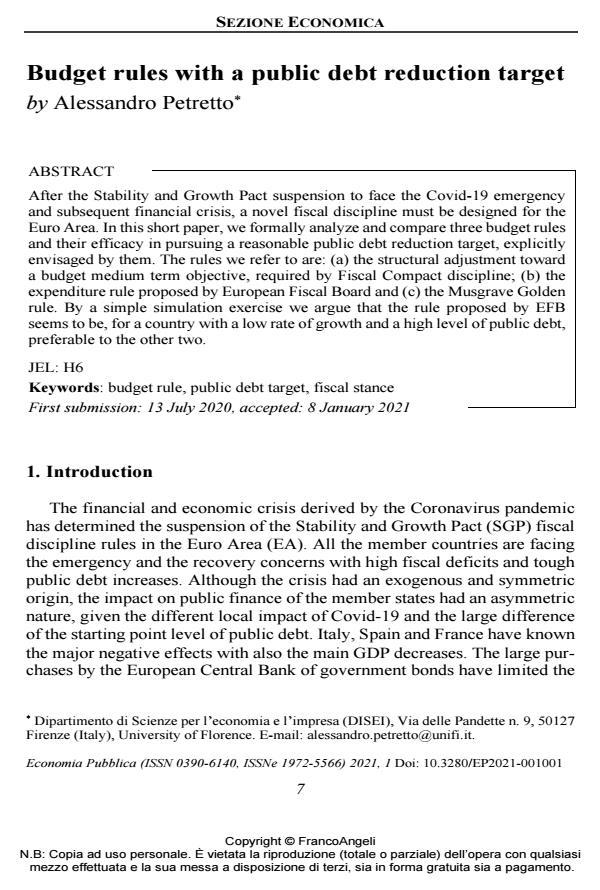Budget rules with a public debt reduction target
Titolo Rivista ECONOMIA PUBBLICA
Autori/Curatori Alessandro Petretto
Anno di pubblicazione 2021 Fascicolo 2021/1 Lingua Inglese
Numero pagine 18 P. 7-24 Dimensione file 148 KB
DOI 10.3280/EP2021-001001
Il DOI è il codice a barre della proprietà intellettuale: per saperne di più
clicca qui
Qui sotto puoi vedere in anteprima la prima pagina di questo articolo.
Se questo articolo ti interessa, lo puoi acquistare (e scaricare in formato pdf) seguendo le facili indicazioni per acquistare il download credit. Acquista Download Credits per scaricare questo Articolo in formato PDF

FrancoAngeli è membro della Publishers International Linking Association, Inc (PILA)associazione indipendente e non profit per facilitare (attraverso i servizi tecnologici implementati da CrossRef.org) l’accesso degli studiosi ai contenuti digitali nelle pubblicazioni professionali e scientifiche
After the Stability and Growth Pact suspension to face the Covid-19 emergency and subsequent financial crisis, a novel fiscal discipline must be designed for the Euro Area. In this short paper, we formally analyze and compare three budget rules and their efficacy in pursuing a reasonable public debt reduction target, explicitly envisaged by them. The rules we refer to are: (a) the structural adjustment toward a budget medium term objective, required by Fiscal Compact discipline; (b) the expenditure rule proposed by European Fiscal Board and (c) the Musgrave Golden rule. By a simple simulation exercise we argue that the rule proposed by EFB seems to be, for a country with a low rate of growth and a high level of public debt, preferable to the other two.
Keywords:Budget rule, public debt target, fiscal stance
Jel codes:H6
- Alesina A. and Tabellini G. (2007). Bureaucrats or Politicians? Part I: A single Policy Task. American Economic Review, 97(1): 169-179.
- Bauman E. and Kastrop Ch. (2007). A new budget rule for Germany. In: Fiscal Policy: Current issues and challenges, proceedings of Banca d’Italia, Banca d’Italia.
- Benassy-Quéré A. et al., 7+7 Report (2018). Reconciling Risk sharing with Market discipline: a constructive approach. CEPR Policy Insight, 91, January.
- Benassy-Quéré A. et al., 7+7 Report, 2 (2019). Euro area architecture: What reforms are still needed, and why. VoxEU.org, May. Benassy-Quéré A., Coeuré B., Jacquet P. and Pisani-Ferry J. (2019). In: A. Petretto,
- F.F. Russo (a cura di). Politica economica, teoria e pratica, 2a ed. it. Bologna: il Mulino.
- Beetsma R., Thygesen N., Cugnesca A., Orseau E., Ellafotou P. and Santacroce S. (2018). Reforming the EU fiscal framework: a proposal by the European Fiscal Board. VOX CEPR, Policy Portal, 26 October.
- Bernardini S., Cottarelli C., Galli G. and Valdes C. (2020). Reducing public debt: experience of advanced economies over the last 70 years. OCPI, Università Cattolica di Milano.
- Buti M. (2018). Fiscal rules: an assessment of recent reforms. National Conference on Public Accountancy, Pisa, 6 December.
- Buti M., Giudice G. and Leandro J. (2018). Deepening EMU requires a coherent and well sequenced package. VoxEU.org, April.
- Buti M. and Messori M. (2020). Next Generation EU: An interpretative guide. Policy Brief 29. Rome: LUISS.
- Calmfors L. and Wren-Lewis S. (2012). What should Fiscal Councils do?. Economic Policy, 26(68): 649-695.
- Claeys G., Darvas Z. and Leandro A. (2016). Proposal to revive the European fiscal framework. Bruegel Policy Contribution, 47, September.
- Darvas Z., Martin P. and Ragot X. (2018a). European fiscal rules require a major overhaul. Le notes du conseil d’analyse économique, 47, September.
- Darvas Z. Martin P. and Ragot X. (2018b). The economic case for an expenditure rule in Europe. VOX, CEPR, Policy Portal, 12 September.
- Debrun L., Eyraud A, Hodge A., Lledo. V., Pattillo C. and Senhadji A. (2018). Fiscal rules: make them easy to love and hard to cheat. IMF blog.
- De Vroey M. (2016). A history of Macroeconomics from Keynes to Lucas and beyond. Cambridge, Ma, USA: Cambridge University Press. ECB (2018). ECB Economic bulletin, 7.
- Elbadawi I., Shmidt-Hebbel K. and Soto R. (2015). Why do countries have fiscal rules. Economic Policies in Emerging – Market Economies Festschrift in Honor of Vittorio Corbo, 21: 155-189.
- European Fiscal Board (2018). Annual Report.
- Feld L., Schmidt C.M., Schnabel I. and Wieland V. (2018). Refocusing the European fiscal framework. VoxEU.org, September.
- Kydland F. and Prescott E. (1977). Rules rather than discretion: The inconsistency of optimal plans. Journal of Political Economy, 85(3): 473-491.
- Kopits G. and Symansky S. (1998). Fiscal Policy Rules. IMF Occasional, Papers n. 162.
- Laubach T. (2005). Fiscal relations across levels of government in the United States. OECD Economic Department Working papers, 462.
- Maskin E. and Tirole J. (2004). The Politician and the judge: Accountability in Government. American Economic Review, 94(4): 1034-1054.
- Musgrave R. and Musgrave P. (1976). Public finance, theory and practice. New York, 2a ed.: McGraw-Hill.
- Nordhaus W. (1975). The political business cycle. Review of Economic Studies, 42(2): 169-190. Pisani-Ferry J. (2018). Euro area reform: an anatomy of the debate. CEPR Policy Insight, 95, October.
- Proietti T., Fioramanti M., Frale C. e Monteforte L. (2020). Un approccio sistemico per la stima dell’output gap dell’economia italiana. Nota di lavoro n. 1, gennaio.
- Tanzi V. (2020). Advanced introduction to public finance. Cheltenham. UK: Edward Elgar.
- Ufficio Parlamentare del Bilancio (UPB 2019). Audizione alla Commissioni bilancio di Camera e Senato, sulla NADEF 2020, 8 October.
- Ufficio Parlamentare del Bilancio (UPB 2020). Rapporto sulla politica di bilancio 2019.
- Vade Mecum (2019). Vade Mecum on the Stability and Growth Pact, Edition 2019 -- https://ec.europa.eu/info/sites/info/files/economy-finance/ip.101_eu.pdf.
- Wyplosz C. (2005). Fiscal Policy: Institutions versus Rules? National Institute Economic Review, 191: 70-85.
Alessandro Petretto, Budget rules with a public debt reduction target in "ECONOMIA PUBBLICA " 1/2021, pp 7-24, DOI: 10.3280/EP2021-001001